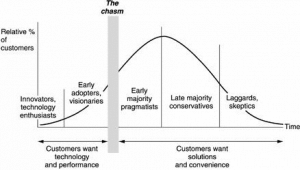
Cycles within cycles
(Updated from the original on 24 June 2014, 3 December 2015)
This week, we’ve been looking at two different lifecycles: the product lifecycle and the development lifecycle – cycles within cycles!
At the macro scale we’re looking at the product lifecycle which spans its evolution from drawing board to market through to eventual withdrawal. On a smaller scale within that cycle, a product will go through many development lifecycle iterations.
Now before we delve deeper, it’s worth considering why we bother labelling these different stages in the first place. Think of both these lifecycles as maps or guidebooks for your product’s journey.
It’s useful to know where you are right now so that you can appreciate the nuances of the local area, understand the culture and behaviours of the people who live there, and know what’s good to do while you’re there. It’s also helpful for context and planning to know where you’ve just come from, where you need to go next and what you can expect when you get there.
The Product Lifecycle #
So we’re clear on the distinctions here, a product’s lifecycle is typically broken down into the following stages:
DEVELOPMENT › INTRODUCTION › GROWTH › MATURITY › DECLINE
Geoffrey A Moore’s book, Crossing The Chasm is necessary reading (albeit with slightly dated examples these days) for any product manager embarking on their product journey. In particular, the book highlights the different characteristics of the people who are likely to become your product’s early adopters, and how they differ to the types of people who will use your product as it matures. In fact, it is this marked difference between the personas of the early adopters and the early majority that creates the chasm into which so many start-ups fall.
One of my class gave a great example about the recent enforced migration by Microsoft of Hotmail users over to Outlook.com. In this situation, Hotmail was arguably in its mature phase, possibly beginning to decline, and Microsoft sensibly made the decision to create a replacement product to avoid losing subscribers to competitors such as Gmail or a rejuvenated Yahoo!.
However, it could also be argued that the characteristics of the Hotmail users, who have probably been using it for a decade and weren’t in a rush to move elsewhere, are quite different to those users expected to embrace a recently introduced product such as Outlook.com. In other words, there’s been a bit of a culture clash, and the enforced migration may have had entirely the opposite effect to what was intended.
So it’s important to understand where your product sits in its lifecycle and how this affects the characteristics of the typical users.
Another helpful thing to consider is that the same product may be in different stages of its lifecycle in different countries – what’s relatively old-school technology in the US may be quite revolutionary in more developing countries. Again, this should inform how you engage with your different markets.
The Development Lifecycle #
There’s usually a bit more variation in the labels for the development lifecycle, but broadly we’re looking at the following phases:
CONCEIVE › PLAN › DEVELOP › EVALUATE › LAUNCH › ASSESS › ITERATE OR KILL
Conceiving your product is your wide-angled research – you’re scanning the horizon for potential problems to solve that are urgent, pervasive and profitable.
Planning is where you focus in on the specifics of the one problem you’re going to solve, this is where your more detailed market and competitive research comes into play. You also define the key measures of success for your product at this point.
Development is when you build the thing – whichever development methodology you happen to use.
Evaluation is arguably something you should be doing throughout the process, not just exclusively at this stage. Whether you’re testing out assumptions prior to development or experimenting with prototypes, or trying out alternate layouts with split testing, you’re always trying figure out whether you’re on the right track.
Launching a product seems like it should be the most fun, but it’s almost always the most nerve-wracking. If you think about it, you’ve got a whole heap of threads that need to be brought together and tied off neatly. Start planning your launch as early as possible to ensure success! Remember also that a launch doesn’t always have to be big. Heathrow Airport learned the lessons from their launch of Terminal 5 back in 2008 by soft-launching The Queen’s Terminal at only 10% of its operating capacity in June 2014.
Assessing how successfully you’ve launched your product is only one aspect of this, you also have to examine how it’s performing in-life. You remember your key measures of success? Here’s where you find out how well you’ve done.
Choosing whether to iterate or kill a product really depends on what your plan was in the first place. If the objective was to create a very short-lived product for a specific purpose, then it may be perfectly reasonable to kill it after one iteration through the cycle. If you’re planning to grow a user base, then further iterations are more likely. Try not to be too emotionally attached to your products so that you don’t lose objectivity on this important decision. Try this article for size for more on the topic.
These two articles may help to focus you on the kinds of information you need to have at your fingertips at different stages of the development lifecycle (part 1, part 2).
References #
- Geoffrey A Moore, Crossing The Chasm
- Me, The Field of Dreams is fiction
- – OMG EOL – LOL
- – Drowning in documentation part 1 and part 2



Leave a Reply